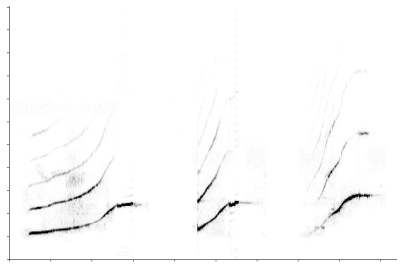
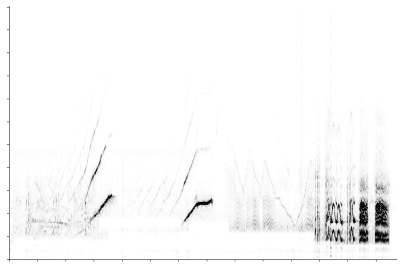
Click on spectrogram to download sound file
Click on spectrogram to download sound file
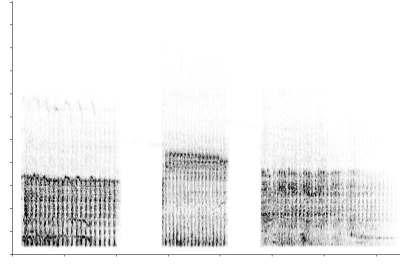
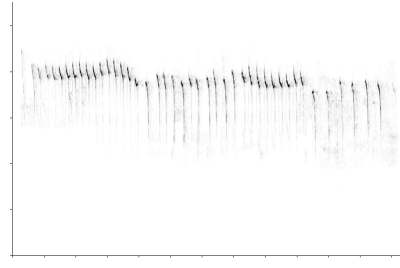
Click on spectrogram to download sound file
Click on spectrogram to download sound file
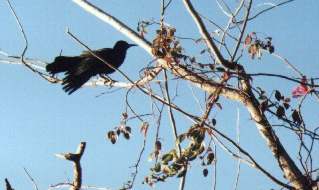
![]()
Song Description:
Great-tailed Grackles produce a truly enormous variety of very high-amplitude vocalizations, most of which are combinations of piercing whistles and guttural sounds. Here I describe four of the more common songs and calls that I recorded.
The grackle's loud song is a bright ascending glissando. The song is sometimes preceded by very low amplitude glissandos which produces an effect of the singer "warming up" before giving the full song.
One of the most common calls is a rapid sputtering which sounds like the firing of a machine gun. Another common call is an extended series of short peep syllables offered in fairly rapid succession.
Vocalizations not explored here include several loud wheezy calls, clattering and creaking sounds, short cluck calls and a low-amplitude growl which may be produced by inflation of the air sac.
![]()
Song Measures:
The piercing whistled song of the Great-tailed Grackle is a single-syllable glissando which rises from an initial frequency of approximately 1000 Hz to a terminal frequency of 2300 to 2900 Hz (average of 2500 Hz). Song length ranges from 1.2 seconds to 3.1 seconds (average of 1.8 seconds). Almost two-thirds of the songs I recorded ended with the high pitch of the glissando being sustained for 0.2 to 1.4 seconds (eg. all three songs in the example above) while a minority of songs ended without this sustained tone. A small minority of songs began suddenly, as though the beginning of the glissando was left out (e.g. the second song in the example above; N = 65 songs from Zoh Laguna, Nueva Becal and Celestun).
"Warm-up songs" are found in two variant forms. In one, the singer gives three to five repeated ascending glissandos which resemble a truncated low-amplitude full song. Consecutive glissandos are connected (ie. no intersyllablic space) and grow longer and higher as this form of the warm-up song progresses (e.g. the first two songs in the example above). The second form of this song is composed of a series of similarly timed low-amplitude ascending and descending glissandos which rise and then fall as many as three times before the full song is given (e.g. the terminal song in the example above). Eight of the 60 songs that I recorded were given after a warm-up introduction. I also recorded two warm-up songs that were not followed by the full song, but by unusual cooing and purring syllables (e.g. the terminal song in the example above).
The sputtery "machine gun call" consists of wide-band syllables (400Hz to 3800 Hz) given in rapid succession at a rate of 15 to 18 per second (ie. they are too rapid to count without the aid of a sonograph). This call typically lasts one to two seconds, although half-second machine gun calls are sometimes heard in tight combination with other vocalizations (N = 12 calls from multiple individuals).
The long peep call is made up of many syllables of equal length (approximately 0.1 seconds). The inter-syllable interval ranges from 0.1 to 0.25 seconds and one call can last as long as two minutes. The bandwidth of these syllables may vary from 200 Hz to 1200 Hz over the course of a call as the syllables shift gradually up and down within a maximum frequency range of 3500 Hz and 4200 Hz (N = 25 bouts from many individuals).
![]()
Singing Behaviour:
Great-tailed Grackles often go through a series of wild contortions while producing both the full song and the warm-up song. The male holds his wings extended down at his sides, points his bill skyward, puffs up his body feathers (but not his head feathers) and almost doubles his girth as he draws in a long breath of air. As the male sings he visibly deflates, often quivering his wings and sometimes thrusting his head upwards and forwards. It is common to see these displays in long countersinging bouts between as many as four males perched within a few feet of each other on a low treetop. I could not discern any regular context in which the "warm-up" song was given, or why this vocalization preceded some full songs but not others.
Machine-gun calls are given throughout the day in a wide variety of contexts by both males and females. This call was often given as birds flew between perches. Male grackles often pursue females by hopping from branch to branch giving long bouts of peep calls. They will often cease to hop, but continue to call after the female has flown away.
Grackles sing throughout the day, with a maximum of song activity in the early to mid morning. Except for the warm-up song, I saw all of these vocalizations given in flight as well as while perched.
![]()
Habitat:
Great-tailed Grackles congregate in large groups in yards and edges of villages throughout the provinces of Yucatan and Campeche, creating such a ruckus that I often wondered how the villagers managed to carry on despite the noise.
![]()
Return
to Bird Songs of the Yucatan Main Page
All
information and photographs copyright Daniel J. Mennill 1999.
No recordings or other information from this site may be used without
written permission from me.
Please email me (dmennill AT
uwindsor DOT ca) and I will happily grant permission for any
non-commercial or education purposes.